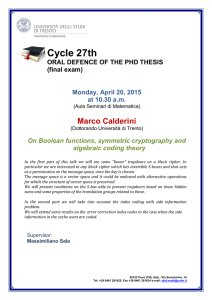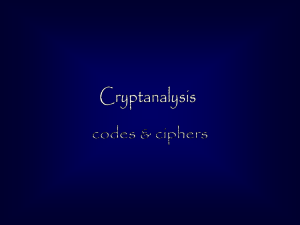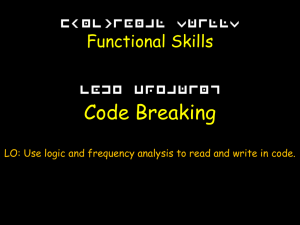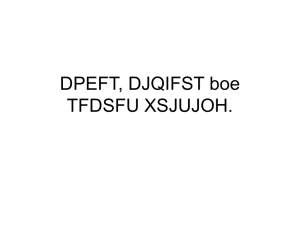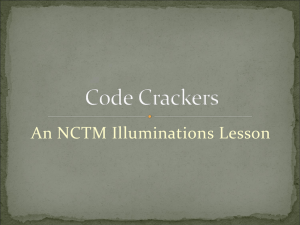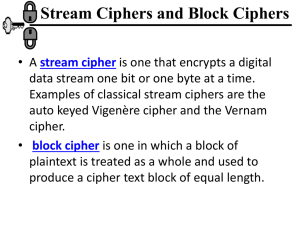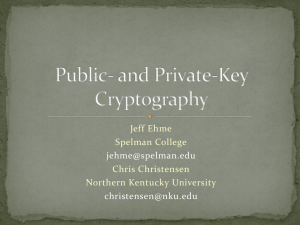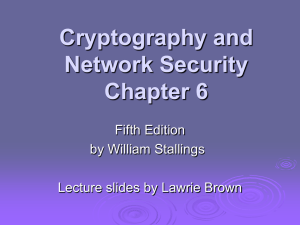Crypto Warfare: The Evolution of Military Cryptology
advertisement
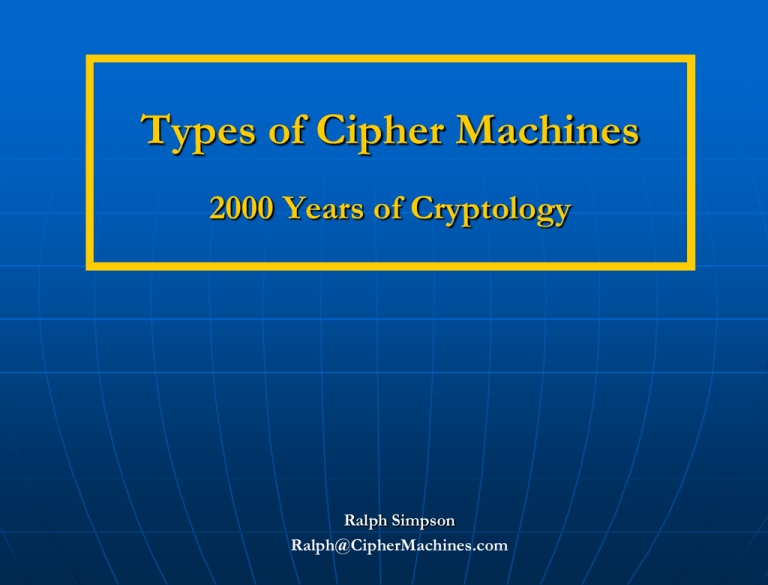
Types of Cipher Machines 2000 Years of Cryptology Ralph Simpson Ralph@CipherMachines.com Agenda Caesar cipher Steganography Transpositions and grills Vigenère cipher disk Code books One-time pads Jefferson wheel cypher Electro-mechanical rotor ciphers Hagelin cipher devices Navajo code talkers cipher IFF code wheels Voice encryption devices Types of Cipher Machines: 2000 Years of Cryptology 2 Caesar Cipher First known use of cryptology in warfare was the Caesar cipher Cipher was a shift of the alphabet by 3 letters – “a” enciphered as “d”, “b” becomes “e”, etc. Weak cipher but effective against an illiterate enemy No cipher device or key to be captured Nero apparently thought the Caesar shift too complex, he used a shift of only one character Any substitution of characters which is constant for an entire message is a monoalphabetic cipher Julius Caesar (100BC – 44BC) First known codebreaking was by Al-Khalil (c. 725-790 AD) who deciphered a letter from a Byzantine emperor by guessing it contained “in the name of God” First systematic solution for monoalphabetic cipher was by Ibn ad-Duraihim (1312-1361) using letter frequency analysis based on the Koran Types of Cipher Machines: 2000 Years of Cryptology 3 Steganography Steganography is Greek for concealed writing Messages were hidden inside objects, swallowed, made into a microdot, behind postage stamp, tattooed on scalp, etc. Both message content and parties are protected George Washington relied on use of invisible ink 2 least significant of 256 bits per pixel removed from picture above yields the image below As detection techniques improved, new invisible inks were developed In 2011, the CIA released US invisible ink recipes from WW1 Later technology uses random noise in jpg pictures, communication protocols, etc. Types of Cipher Machines: 2000 Years of Cryptology 4 Transpositions and Grills Transposition is a physical rearrangement of letters, making the message unintelligible A grill is usually a piece of paper with holes cut to write and display the message among a larger set of letters, making a transposition more user friendly In 1550, Girolamo Cardano suggested writing a secret message in a grill, then filling in the rest of the page so the letter looks intelligible, which combines transposition with steganography KL-99 US Navy grill Transposition, by itself, is not very strong, so it is usually combined with some other type of cipher In WW1, the German ADFGX cipher combined transposition and a diagraphic cipher, which changed pairs of letters into another enciphered pair Types of Cipher Machines: 2000 Years of Cryptology 5 Vigenère Cipher Disk Vigenère cipher invented in 1467 by Leon Battista Alberti, 56 years before Vigenère was born Polyalphabetic cipher changes cipher several times in a message – thwarting letter frequency analysis Alberti claimed the cipher was unbreakable, 450 years later Scientific American magazine agreed Disk with keywords simplified polyalphabetic ciphers Alberti drawing of 1467 Polyalphabetic ciphers broken by using letter frequency to decipher the same letter position of several messages and by deciphering keywords Used by South in Civil War and consistently broken by the Union Army Vigenère disk still used in modern times – GRA-71 burst encoder, Whiz wheel Types of Cipher Machines: 2000 Years of Cryptology One of 5 surviving CSA disks 6 Code Books Ciphers change message by each letter, codes change whole words or phrases Code books were in widespread use for centuries – until WW2 Codes also saved money in telegraph costs Usually, codes were combined with other ciphers Code books of up to 100,000 codes are often kept for years Example from 1888 code book If code book is compromised, sending out new code books is very cumbersome and risky US spies copied Japanese code book before WW2 Types of Cipher Machines: 2000 Years of Cryptology 7 One-Time Pads One-time pad is the only unbreakable cipher Requires every letter to be changed by random number and used only once Popular with spies and named after small pads of random numbers Thought to be invented in 1919 by Gilbert Vernam and Joseph Mauborgne Hagelin one-time pad and M-209 First use of one-time pad was in teletype, using Baudot codes to automatically encipher and decipher messages without operator involvement NSA called this patent "one of the most important in the history of cryptography" Used for high-level messages, transporting one-time tapes too cumbersome & risky In 2011, it was discovered banker Frank Miller invented the one-time pad in 1882 One-time pads were broken by operator error or electro-magnetic emissions – ex. Venona project, Moscow/Canberra messages, German Foreign Office in WW2 Types of Cipher Machines: 2000 Years of Cryptology 8 Jefferson Wheel Cypher and M-94 Yes, invented by our third president in mid- 1790s, possibly inspired by Chinese combination locks and discovered in his writings in 1922 Each wheel has a different random alphabet, the key is the order of wheels on spindle Message spelled out on one row, any other row sent for a strong and user-friendly cipher Only existing Jefferson Wheel Cypher US Army M-94 Coincidentially re-invented in 1922 by Joseph Mauborgne as M-94, used 1922-1943 Mauborgne also re-invented one-time pad and demonstrated first aircraft use of 2-way radio, later Maj. Gen. and Chief Signal Officer Types of Cipher Machines: 2000 Years of Cryptology 9 Electro-Mechanical Rotor Ciphers Electro-mechanical rotor ciphers invented and patented by 4 people in 4 countries after WW1 Most famous was the German Enigma machine Current went through multiple rotors to change each letter several times Key was the selection and order of rotors with addition of plugboard for Enigma Despite overwhelming odds, Enigma was broken by Polish, then British and US codebreakers, significantly shortening WW2 US altered British mechanical bombe, using tubes for memory - first computer 2003 discovery - electro-mechanical rotor Infamous Nazi Enigma machine cipher was first invented in 1915 by 2 Dutch Naval Officers, but kept secret Types of Cipher Machines: 2000 Years of Cryptology 10 Hagelin Cipher Devices Early Hagelin machines used electromechanical rotors based on the Swedish patent Beginning with C-35, including US M-209, later Hagelin devices used purely mechanical means to randomly select a reciprocal alphabet Hagelin got his inspiration for this new cryptologic technology from coin changers Swedish Transvertex HC-9 used same technology, Transvertex CEO was Director in Hagelin’s company – “HC”- Hagelin Cipher Hagelin later made deal with US NSA to give US access to the world’s secrets for 4 decades Hagelin M-209 cipher Hagelin/NSA backdoor disclosed to Russia & Israel by spies Aldrich Ames & Jonathan Pollard Russia told Iran, who blew the cover on this greatest sting in history in 1993 Types of Cipher Machines: 2000 Years of Cryptology 11 Navajo Code Talkers Navajo language was oral only and hard to master and understand - 30 non-native speakers in WW2 US Marine Corp demonstrated ciphering, sending and deciphering a message in 20 seconds by Navajos vs. 30 minutes required by an M-209 One of few ciphers not broken by the enemy in WW2 Navajo code talkers were in every major battle in the Pacific from Guadacanal to the end of the WW2 Seven code talkers were KIA, none captured Navajo code talkers were used in Korea and the Navajo code talker on TBY radio Image on commemorative medal beginning of the war in Vietnam Use of Navajo code talkers was declassified in 1968 and the original 29 code talkers were awarded Congressional Gold Medals in 2000 Types of Cipher Machines: 2000 Years of Cryptology 12 Identify Friend or Foe Cipher Wheels Invention of radar and faster planes required pilots to identify enemy aircraft before visual sighting IFF radios were invented in WW2, but cryptology was needed to prevent the enemy from using the radio from a downed plane Germans were the first to use IFF which included encryption keys, but the British made a device to locate the German plane, so the IFF was not used P-51 Mustang Cipher wheel in dynamotor First US IFF radio was the ABA-1, used a cipher wheel inserted into the dynamotor of the radio Crypto was crude but effective, one of 10 wheels was selected for use that day IFF later developed into the transponder, which is in every aircraft today Types of Cipher Machines: 2000 Years of Cryptology 13 Voice Encryption Early voice scramblers added noise to a voice message or changed frequencies / time splices Analog technology used by Roosevelt & Churchill h was regularly broken by Nazis before 1943, until first digital voice encryption, SIGSALY MS-2001, KY-57 and KY-28 AT&T TSD-3600E with Clipper Chip Analog technology (KY-28) was later upgraded to more secure digital encryption (KY-57, MS-2001) In 1993, US NSA Clipper chip planned to be mandated in every US communication device Design flaw of Clipper chip spurred widespread adoption of open standard, public key encryption Types of Cipher Machines: 2000 Years of Cryptology 14

